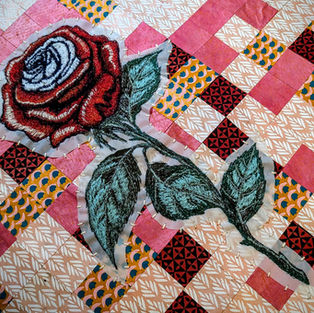STEGANOGRAPHY
OXT
Art wrapping paper, thread.
122 x 98 cm.

Artist Statement
On the science of OXT
OXT is the name for the sequence of nucleotides (gene) that codes for the hormone oxytocin. In humans, it is primarily produced by two centers located at the base of the brain in the hypothalamus. The neurons in those centers are known as magnocellular neurosecretory cells. As their name implies, they are distinguishable for their larger size. These neurons are unique due to their capacity to produce and release the hormone directly into the bloodstream, utilizing their axon projections to reach the posterior pituitary.
Oxytocin was first described in 1906 by Sir Henry Dale, who observed that posterior pituitary gland extracts caused uterine contractions. Vincent du Vigneaud was awarded the Nobel Prize in Chemistry (1955) for fully sequencing and synthesizing oxytocin (1953).
The multiple functions associated with this nine-amino acid peptide hormone/neurotransmitter include reproduction, social bonding, and overall well-being. Oxytocin stimulates uterine contractions during childbirth and the milk ejection reflex during breastfeeding. It is linked to social behaviours like trust, bonding, romantic attachment, and recognition. It can also decrease levels of stress and anxiety. Because of the above, the peptide has been nicknamed "the love hormone."
Even before our existence, oxytocin influences the trust, bonding, and affiliation between those who will become our parents. It contributes to ovarian function, and it produces the contractions responsible for ejaculation. When our mothers are ready to give birth, oxytocin produces the strong contractions that dilate the cervix and move the baby out. Once birth, it stimulates milk ejection, sustaining our first months of life and contributing to the bond mother-child.
Oxytocin helped us to bond with others, recognize them, and form friendships. Its release promotes positive emotions, contributing to feelings of well-being and resilience. Oxytocin envelops us gently as an agent of love, decreasing stress and anxiety levels while promoting relaxation and psychological stability.
On the Steganography of OXT
I wanted to create a dialogue between MAOA, a gene commonly referred to as the "gene of hate," and OXT, the gene associated with the "love hormone." In this dialogue, I aimed to utilize the science behind the two genes to contrast their resulting behavioural outcomes, seeking points of commonality and divergence.
I used paper squares to codify the nucleotides in both artworks (~1600 for MAOA, and ~500 for OXT). However, in MAOA, I used a palette of eighteen designs, whereas in OXT, I used only four. Eighteen designs for only four units of information create a broader and more complex starting point for decoding. This transforms MAOA into a complex gene to decipher, a feature that borrows from the complexities of hate expression among humans. OXT is a breath of fresh air for anyone interested in unravelling its code. This is a purposeful choice; it signifies the simplicity of love.
The eighteen paper designs in the code for MAOA also illustrate the variations that hate employs in society, contributing to its normalization and concealment in daily activities. Systemic racism is a concealed form of hate. Hate is costly and ostentatious, yet it somehow camouflages perfectly among humans. We wear it like a cozy blanket changing colours and shapes, and reigniting, spreading anew in another place when you mistakenly thought it was over. On the other hand, love is proud of its soft colours and warm; it welcomes introduction and engagement, inviting touch, embraces, and kisses.
The embroideries in both artworks also invite us to reflect on the sociological aspects of both genres. As I have explained before, the tansies are medicinal and also toxic, becoming at some point in the Victorian Age, a symbol for hate and war. On the other hand, OXT is decorated with a red and white rose. The rose is a symbol of love in floriography, and while red represents passion, white stands for purity and candid feelings, illustrating the spectrum that love can encompass.
Both genes are actively involved in cognition, and similarly, both feelings are actively at war inside us, almost like the old battle between good and evil.
The sequence created for MAOA contains mutations, whereas the OXT sequence does not. MAOA is always more likely to be affected by physical changes due to his size, illustrating the quick reactions that hate triggers in our emotions. OXT is so well conserved through evolution that you can find orthologs (proteins derived from genes that are related across species but undergo minor changes from organism to organism) in every vertebrate and even invertebrate. In most cases, social behaviours are closely linked to the peptide.

























